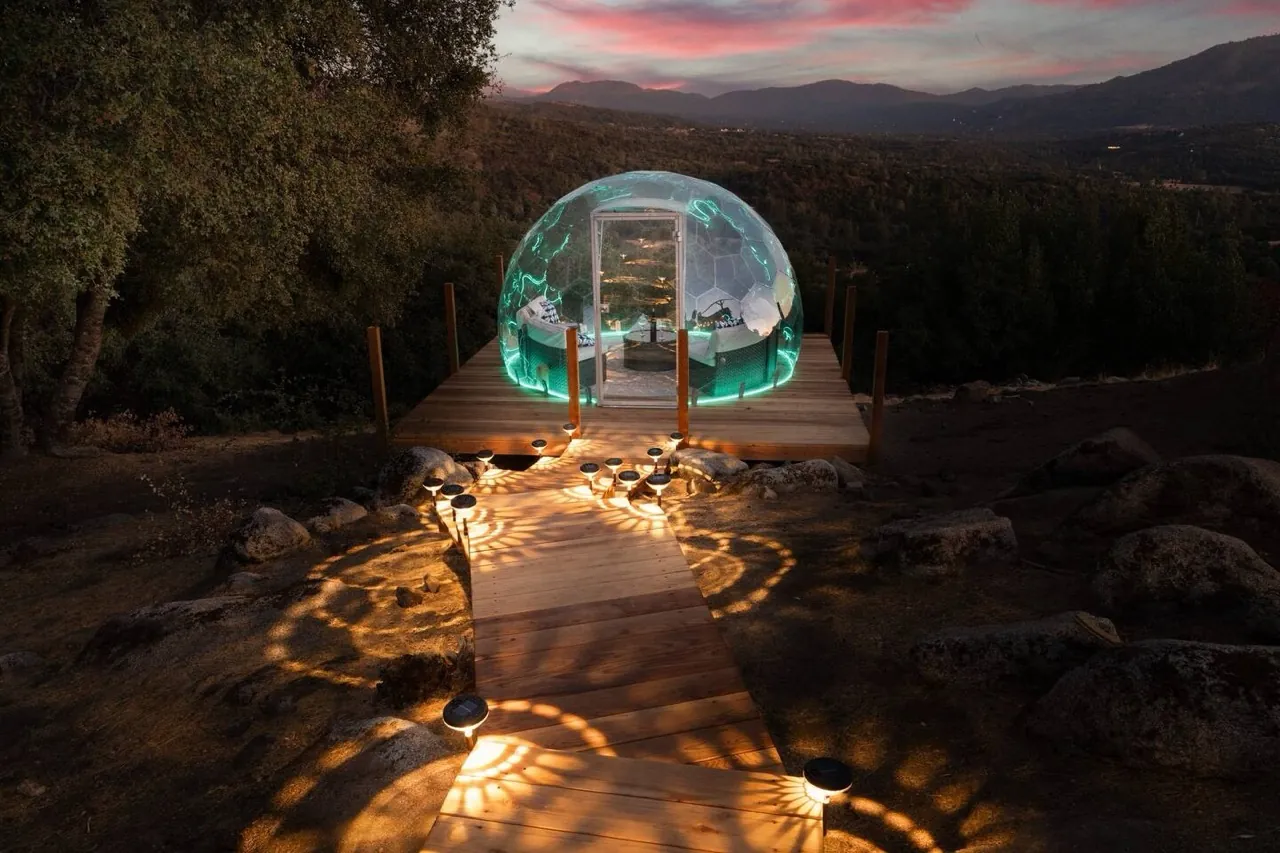If you’re looking into garden pods, you might have come across the term ‘geodesic dome’ and be scratching your head over what this means exactly.
Wonder no more – we explain everything you need to know about geodesic domes, including how they’re constructed, their benefits and what they’re used for. You’ll also discover how to build a geodesic dome and why it pays to use a ready-made kit. Let’s dive in by first answering the question that’s probably landed you here…
Table of contents:
- What is a Geodesic Dome?
- The Invention of the Geodesic Dome
- Materials Used to Make Geodesic Domes
- Durability and Strength of Geodomes
- Other Advantages of Geodesic Domes
- Geodesic Domes’ Cultural Evolution
- What’s the Common Use of Geodesic Domes Today?
- Emerging Trends in Geodesic Dome Applications
- Geodesic Dome Design: The Art and Science of Dome Architecture
- Geodesic Dome Kits
- Geodesic Domes: Poised for a Modern Comeback?
- FAQs about Geodesic Domes
What is a Geodesic Dome?
A geodesic dome (or a geodome) is a self-supporting structure made up of interlocking hexagons or triangles. These are strong shapes that connect together to form a highly stable half-sphere. Geodesic domes are a fine example of beautiful architecture – they look somewhat futuristic and tend to draw the eye.
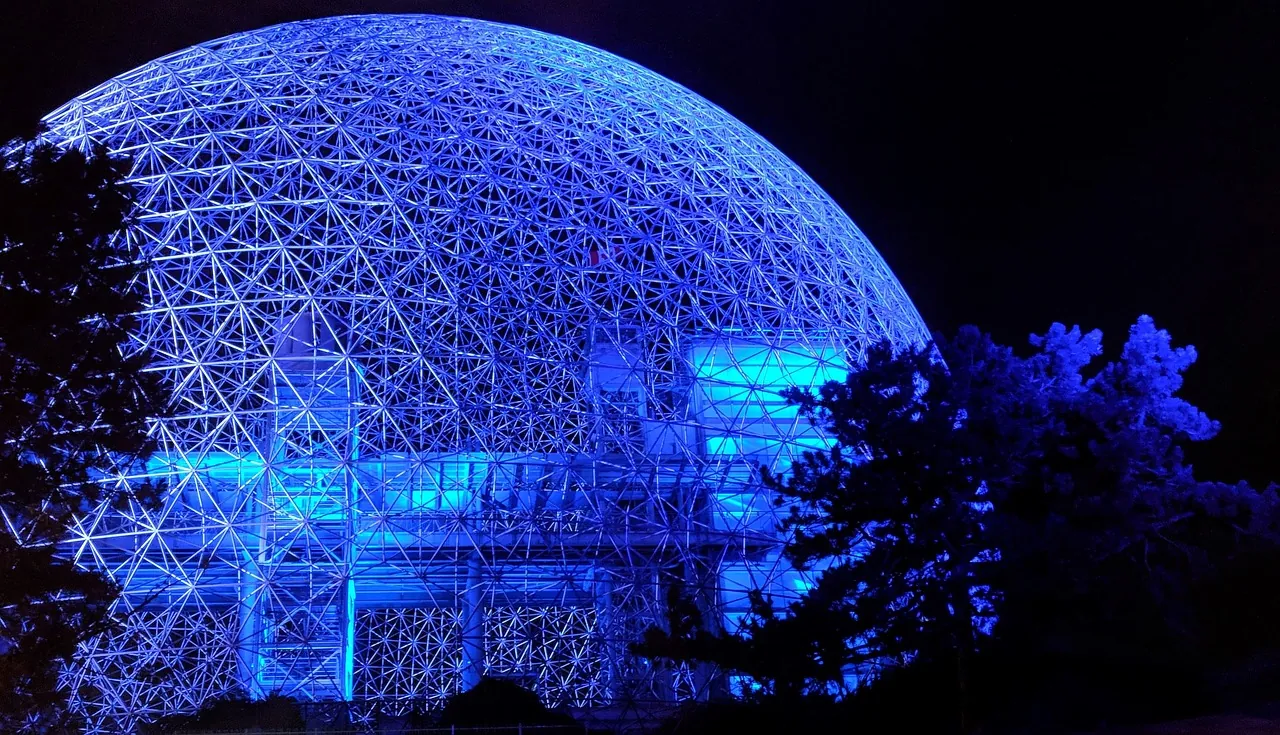
Yet, despite their modern aesthetic, geodomes were first invented about 100 years ago.
The Invention of the Geodesic Dome
A German engineer called Walter Bauersfeld was the original mastermind behind this revolutionary structure. In the 1920s, he designed a planetarium to sit on top of a Zeiss factory in Jena. It had to be lightweight, big enough to accommodate many people, and strong enough to withstand bad weather. After several years of calculations and trials, Bauersfeld and his team settled on a geodesic dome design that would meet all those needs. Hence, Planetarium Jena was built.
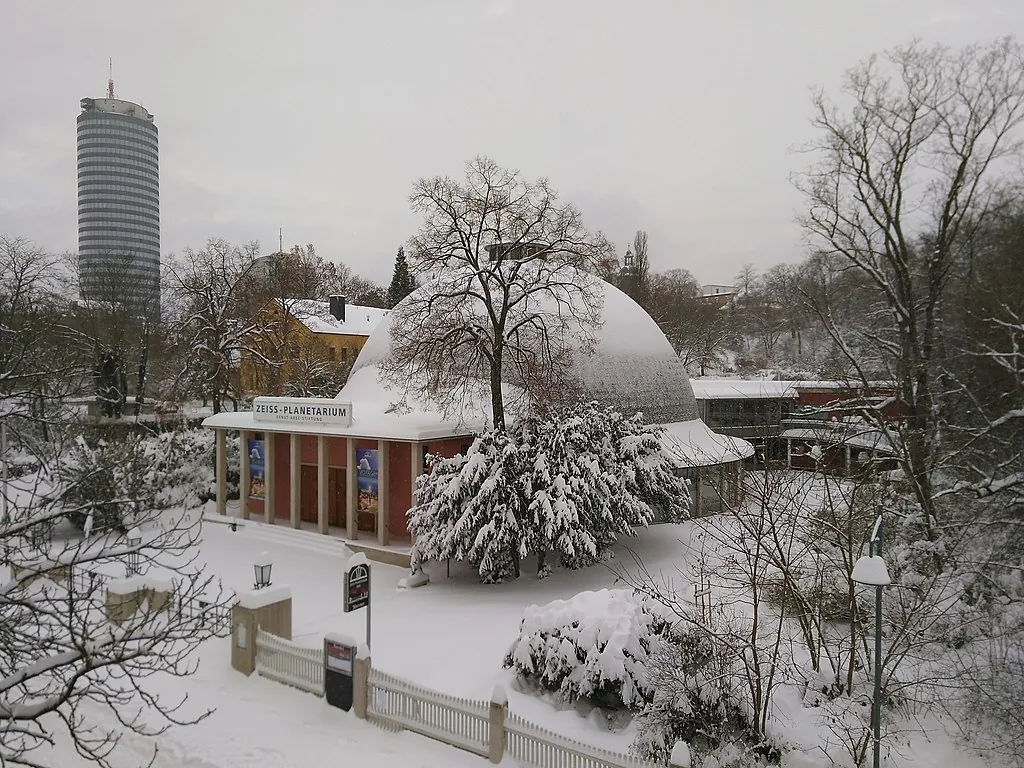
Zeiss-Planetarium, Jena
Fast forward a few decades to the 1950s, and it was American architect Buckminster Fuller who applied for U.S. patents and popularised geodesic dome structures, gaining international recognition for his work. Check out the impressive Montreal Biosphere, one of Fuller’s most famous projects, originally made from steel tubes and plastic triangles.
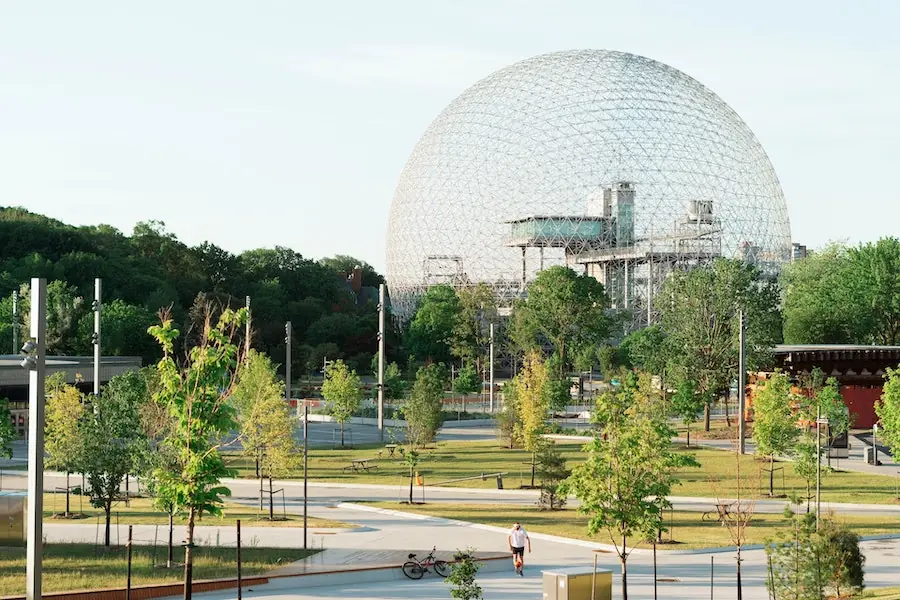
The Biosphere, Montreal
If you’re an original Battlestar Galactica fan, you may recognise it from one of the episodes!
We’ll explore the fascinating evolution of geodesic domes through the decades in greater detail shortly. But first, let’s focus on the key technical aspects that underscore their remarkable value.
Materials Used to Make Geodesic Domes
Geodomes are made from various materials today, including polycarbonate, glass, wood, metal or PVC. We use polycarbonate (a fully recyclable thermoplastic material) in the construction of our Hypedome geodesic hexagon dome. It’s a sound choice for several reasons.

Firstly, polycarbonate is immensely strong – up to 200 times stronger than glass. It also offers brilliant impact resistance, UV protection and energy efficiency (less energy is needed to achieve the perfect temperature inside the dome). And it’s lightweight, meaning it’s easier to fabricate, transport and handle. These qualities make polycarbonate geodesic domes extraordinarily durable and able to withstand hot, cold and windy weather conditions.
In addition to their strength and durability, the choice of materials for geodesic domes is also guided by environmental considerations. Polycarbonate, for instance, is not just robust; it’s fully recyclable, aligning with the ethos of sustainable architecture. This alignment with eco-friendly practices is particularly vital in our current era, where sustainable living is not just a preference but a necessity. In embracing these materials, geodesic domes embody a commitment to not only enduring design but also to a planet-friendly future.
Durability and Strength of Geodomes
Geodesic domes play an important role in sustainable and eco-friendly building design. They offer high energy efficiency and can be constructed with recyclable materials. They also require very few resources compared to traditional buildings and can be built without any heavy gear. What’s more, all you need to build the majority of types of domes (including Hypedomes) can be flat-packed and easily transported, which also reduces their carbon footprint.
They’re also one of the strongest structures in architecture, partly because of the way they’re built. Geodomes contain side-by-side triangles or hexagons that transmit weight and stress evenly. The result is a network of panels that are stable and resistant to wind pressure and heavy loads.
Delving deeper into the engineering marvel of geodesic domes, it’s essential to understand the concept of ‘tensegrity‘ that underpins their stability. This term, coined by Buckminster Fuller, combines ‘tension’ and ‘integrity’ to describe how these structures achieve their remarkable strength. In a geodesic dome, the interconnected struts (rigid components) distribute stress evenly across the structure, while the tensioned components (like cables or the outer skin) maintain the shape and provide additional support. This unique combination allows for a lightweight yet robust architecture that can withstand significant external loads and pressures.
The geodesic dome’s ability to evenly distribute stress makes it exceptionally resistant to environmental challenges like heavy snowfall, strong winds, and even seismic activity. By leveraging the principles of tensegrity, geodesic domes aren’t just aesthetically pleasing; they represent a pinnacle of efficient, resilient architectural design.
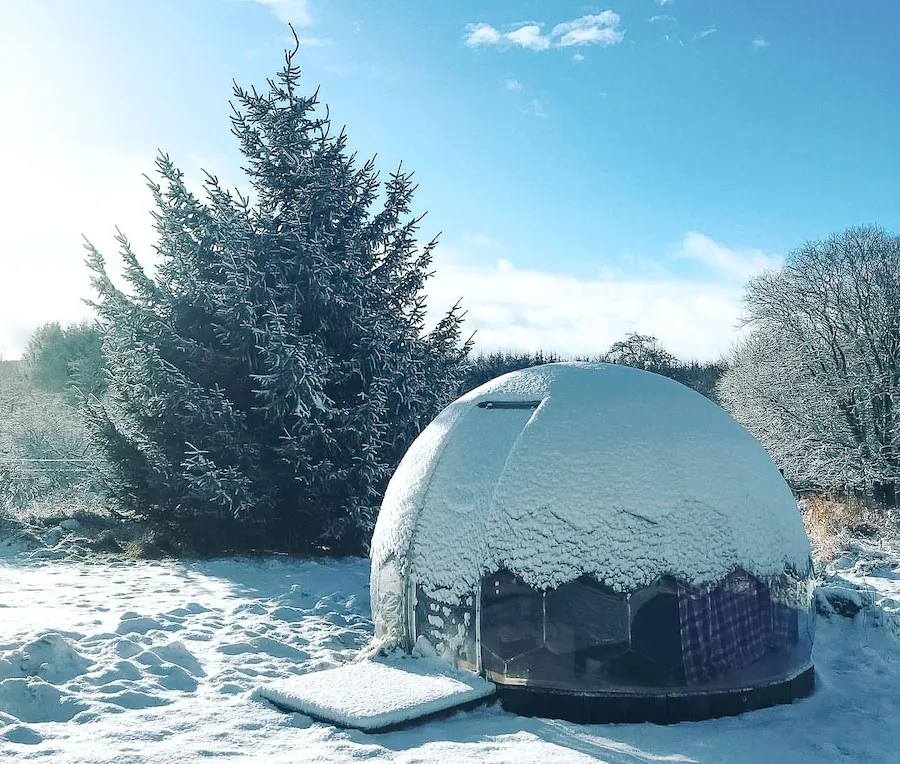
A geodesic dome’s stability comes with its large surface area to volume ratio, which helps minimise wind impact and prevents the structure from collapsing. Enclosing the maximum interior space with the least surface area requires less materials. This efficient use of resources leads to lower costs compared to more traditional structures. It can also support an astonishingly large amount of mass compared to the mass of the dome itself. As we’ve touched on, using highly durable materials for construction, like polycarbonate, adds to the structure’s overall strength.
Other Advantages of Geodesic Domes
The unparalleled strength and durability of a geodesic dome structure aren’t just engineering feats; they also pave the way for sustainable living and other important aspects.
- Energy efficiency – the spherical shape of geodesic domes is simple yet mighty. It maximises the interior space while minimising the exterior surface area. Geodesic domes can be designed to be energy efficient – their curved shape helps to conserve heat and reduce energy costs (resulting in less fossil fuels being burned if using these for heating). It’s much easier to regulate air temperature within a dome compared to a traditional building design. Domes are also less susceptible to temperature changes outside. Significant energy savings offer a sustainable shelter solution that respects the delicate balance of our planet’s resources.
- Low environmental impact – Geodesic domes provide efficient insulation, reducing energy consumption and consequently carbon emissions, a vital factor in combating climate change. Their design requires less material than traditional buildings and their longevity further enhances sustainability, making them a wise choice for eco-friendly construction.
- Usable space – geodesic domes are incredibly efficient in terms of their use of materials, as they use less material to cover a given area than a traditional flat roof structure. They have no corners, so there’s no wasted space – just more room for relaxing, entertaining, working out and dining (among many other activities).
- Allows for natural lighting – geodomes let ample light through their panels, creating a bright open space in the daytime and reducing the need for artificial lighting until it’s dark outside. The abundant natural light in geodesic domes not only reduces energy consumption but also aligns with biophilic design principles, fostering a harmonious connection between indoor spaces and the natural world. A fully transparent dome (like the Hypedome S Clear) is perfect for an art studio or hobby room where natural light is paramount.
- Visual appealing – geodesic domes offer a functional yet striking architectural style. Their seemingly intricate network of panels looks modernistic and beautiful. People find geodomes awe-inspiring and like to admire them from inside and out.
- Low maintenance – some geodesic domes are made from durable materials like polycarbonate, making them weather resistant and able to withstand natural wear and tear. They’re usually easy to clean, too – polycarbonate domes can be washed with water or a mild detergent (and even power washed).
- Portability – geodomes are modular in design, making them easy to transport and build (and deconstruct if needed).
- Multipurpose – geodomes are highly adaptable and can be used for all sorts of purposes – as a pod for the garden to extend living space or even for expanding work environments. Let’s break down some of the uses for geodesic domes in detail.
The sustainability and adaptability of geodesic domes have not only made them a choice for eco-conscious builders but have also cemented their place in cultural history, from countercultural movements to modern festivals.
Geodesic Domes’ Cultural Evolution
The geodesic dome has integrated into American culture, symbolizing innovation, sustainability, and community. Since the 1960s, it has been prominent in countercultural movements, and today, it is notably present at events like Burning Man, representing unity and environmental consciousness. This journey is a slice of the American dream, showcasing a blend of bold ideas and designs that last.
Fuller’s Further Impact on Geodesic Domes and Society
The journey of geodesic domes is a narrative of ingenuity and a quest to revolutionise human shelter. Initially, R. Buckminster Fuller, the name most synonymous with these domes, sought to leverage modern technology to make living spaces more efficient, comfortable, and economically available to the masses. He saw potential in applying tension instead of compression in building materials, leading to the creation of homes that were both lighter and sturdier, and significantly more cost-effective than their traditional counterparts.
His visionary work in the early 20th century set the stage for what would become a symbol of futuristic living, leading to prototypes that could be rapidly produced and assembled. Despite facing challenges such as union constraints and financing woes, Fuller’s unwavering dedication laid the foundations for the geodesic domes we’re familiar with today.
Fuller was more than an architect; he was a visionary and a philosopher in the realm of built environments. His Spaceship Earth concept portrayed our planet as a collective journey, emphasizing the need for cooperation for the sake of our mutual survival. He foresaw a world where technology would be leveraged to tackle grand-scale issues, promoting a holistic approach to design that integrates scientific principles into the conscious design of our total environment. His work gained significant acclaim in the architectural community at the 1954 Milan Triennale, showcasing a cardboard dome that echoed his principles of sustainability and innovation. This acclaim was bolstered by the military’s interest in using geodesic domes for quick-to-deploy, sturdy housing solutions, further cementing Fuller’s influence in both public and professional domains.
Geodesic Domes and the Hippie Movement
In the 1960s, the geodesic dome became a symbol within the hippie movement, representing a departure from traditionalism towards sustainable, communal living. Pioneers of this movement, seeking harmony with nature, found the dome’s low-impact design and the do-it-yourself building approach to be in perfect alignment with their back-to-land ethos. Drop City, a rural commune established in 1965 in Colorado, is a landmark in this regard, becoming the first notable settlement to use domes as dwellings, and setting a precedent for sustainable community designs.
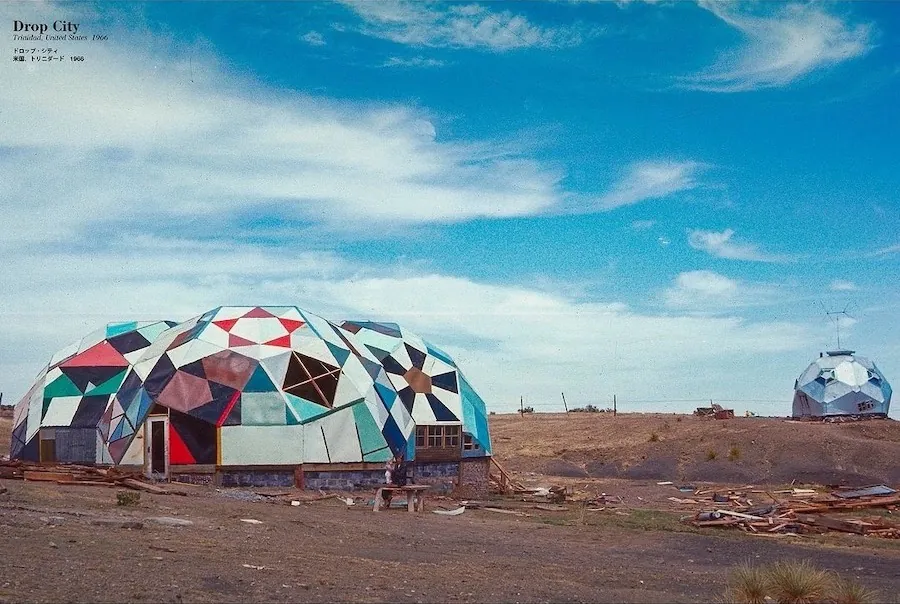
Drop City, source: instagram.com/au_magazine
Whole Earth Catalog
The Whole Earth Catalog, envisioned by Stewart Brand in the late 1960s, stood as a compendium for self-sufficiency and sustainable living, drawing heavily on Buckminster Fuller’s “Spaceship Earth” philosophy. This catalog became a touchstone of the counterculture era, providing an extensive toolkit for those eager to forge a life outside the confines of mainstream society. Its pages featured everything from personal computers to ecological architecture, from solar power to organic farming, DIY projects, and more. It aimed at empowering individuals to build, create, and learn independently.
The Whole Earth Catalog transcended its role as a mere publication, becoming a manifesto for a generation seeking environmental harmony and alternative lifestyles. The catalog championed a do-it-yourself approach, which anticipated our modern digital age of widely accessible information. It was a precursor to the internet, hinting at a future where anyone could easily obtain a vast array of resources with just a simple click. The Whole Earth Catalog reinforced geodesic domes as icons of a movement that valued self-reliance, innovation, and a minimal ecological footprint.

Whole Earth Catalog, source: Wikimedia Commons
The legacy of the Whole Earth Catalog persists, echoing in today’s sustainability efforts and the continued popularity of geodesic domes among those seeking environmentally conscious living solutions. Its “access to tools” philosophy remains a rallying cry for a generation striving for ecological responsibility and community-driven innovation, making the Whole Earth Catalog an enduring symbol of the nexus between counterculture and modern environmentalism.
Burning Man and the Continuation of Utopian Ideals
Originating from a modest gathering on San Francisco’s Baker Beach in 1986, Burning Man began when a group of friends led by Larry Harvey and Jerry James built an 8-foot wooden figure of a man and set it ablaze on the summer solstice. This act of radical self-expression ignited an annual tradition that grew exponentially over the years. By 1990, the event had outgrown the beach and found its new home in the expansive playa of the Black Rock Desert in Nevada.
Each year, tens of thousands converge in this desolate landscape to create Black Rock City, a temporary metropolis dedicated to community, art, self-expression, and self-reliance. The principles that guide the experience are not only about personal freedom but also about responsibility to the collective. The event is governed by a “leave no trace” philosophy, ensuring that the desert is left pristine, reflecting a deep respect for the environment.
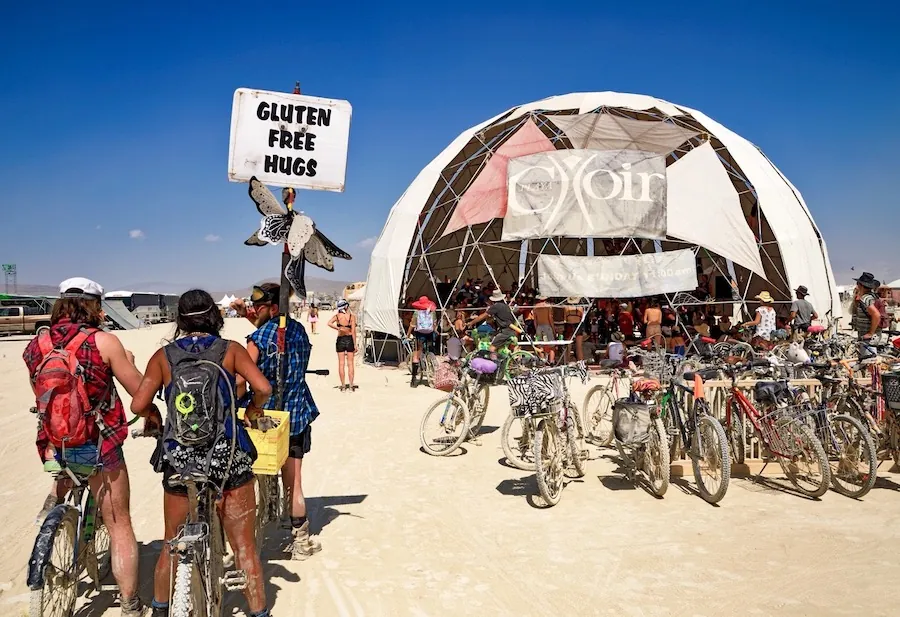
Burning Man, Photo by Philippe Glade, source: burningman.org
Within this context, geodesic domes have become a signature feature of Burning Man’s infrastructure. They serve as a practical choice for their durability and resistance to the desert winds, but more importantly, as iconic structures that represent the festival’s cutting-edge synthesis of art, architecture, and community living. The domes are a canvas for the event’s pulsating life, hosting everything from dance floors to temples of reflection, embodying the ephemeral nature of Burning Man itself — a city that appears once a year, only to disappear, leaving no trace but the memories and inspirations it imparts to those who participate.
Dome Design Reimagined in Las Vegas' Sphere
Tracing the cultural legacy of geodesic domes brings us to Las Vegas’ contemporary architectural marvel, The Sphere. This isn’t just another flashy Vegas venue; it’s a futuristic nod to the geodesic principles of strength, lightness, and innovation. The Sphere takes the core ideas behind geodesic domes — the push towards new materials and forms — and rockets them into the 21st century with a high-tech twist that’s all about immersive experiences.
Clad in a digital exoskeleton, The Sphere is a living testament to the evolution of geodesic design, morphing from Buckminster Fuller’s visionary domes to a digital amphitheater that can dazzle and connect with audiences on a whole new level. Here, the dome’s ethos of creating spaces that bring people together gets a modern makeover, combining cutting-edge tech with communal vibes. It’s a place where architecture, entertainment, and the digital revolution converge, showing us that the cultural journey of the geodesic dome is far from over — it’s just getting a glitzy, high-tech reboot in the heart of Vegas.
Envisioned as a venue for a new era, The Sphere is designed to host a variety of events that redefine live entertainment, with its facade enveloped in an ultra-high-resolution LED screen, the largest on the planet, designed to deliver jaw-dropping visuals that complement the action inside.
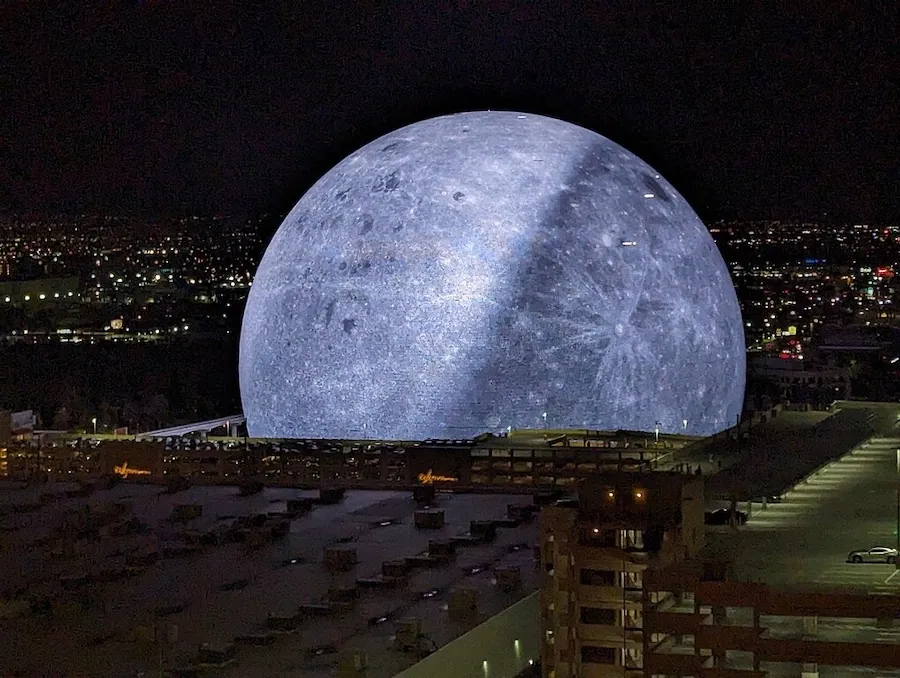
The Sphere, source: Wikimedia Commons
Geodesic domes have evolved significantly from their historical roots, adapting to various cultural contexts. This evolution naturally leads us to their diverse modern applications, demonstrating their versatility in contemporary settings.
What’s the Common Use of Geodesic Domes Today?
Geodesic domes are remarkably flexible and versatile; they can be turned into comfortable and unique spaces and kitted out with accessories like insulated flooring, carpet, furniture and lighting. They can be made in a variety of sizes and colours and are often used for:
Glamping pods
Many people like the idea of sleeping under the stars but don’t want to get too close to nature and risk sharing their sleeping area with bugs and insects. Hence, glamping (luxury camping) is a rising trend. Spending the night safely inside a warm, glamping geodesic dome is a unique experience, offering guests ample living space.
The domes’ large windows and transparent sections allow for unobstructed views of the surrounding landscape, enhancing the connection with nature while ensuring privacy. Inside, these domes are often equipped with high-end amenities, including comfortable bedding, stylish furnishings, and sometimes even climate control, offering a cosy and upscale outdoor living experience.

Interested in glamping pods? Check how Hypedome can become a cozy outdoor bedroom.
Outdoor rooms
Two main reasons outdoor living spaces are popular are that they offer extra space without the hassle of moving home while providing the health benefits of being outside. Building a geodesic dome in your garden makes for an attractive addition to your property and gives you a dedicated space for escapism, alfresco dining or entertaining friends. Garden domes are also used as outdoor offices, gyms or yoga retreats.
A DIY geodesic dome is a brilliant choice for a garden pod project. It can be used to extend your living space outside so you can enjoy the beauty of nature come rain or shine.
By using a geodome kit, much of the hard work will be done for you in terms of design, quality materials and constructing the various components. If you follow the build instructions and correctly anchor your geodome, the finished result will be a durable, energy-efficient, low-maintenance enclosed outdoor space.
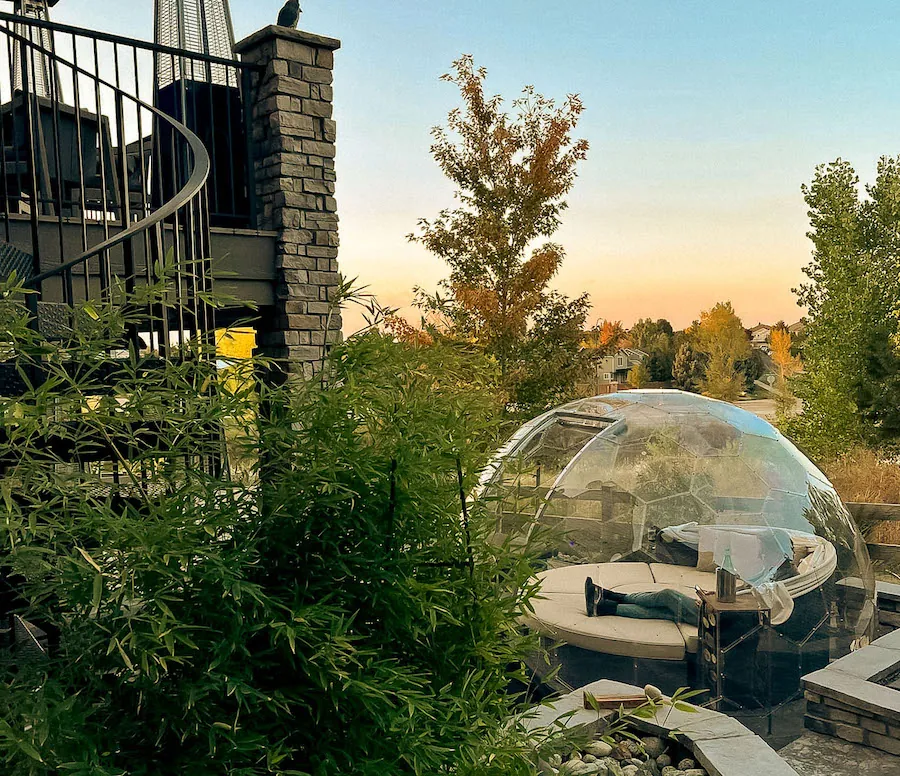
Ready to embark on your geodesic dome adventure? Opt for one of Hypedomes to ensure a delight in owning your very own dome for year-round use.
Greenhouses
A clear backyard geodesic dome is a great alternative to a traditional greenhouse. The natural light and efficient use of space are ideal for green-fingered folk wishing to grow plants and vegetables. This design also maximizes interior space, allowing for more plants to be grown in a smaller footprint. The unique design of geodesic domes enables superior air circulation compared to traditional greenhouses. This enhanced airflow helps to regulate temperature and humidity more effectively, reducing the risk of plant diseases and pests. As a result, plants grown in these domes often exhibit healthier growth and yield, making them a practical and sustainable option for both amateur and professional gardeners.
Event venues
Geodesic dome tents are often used for weddings, parties, concerts and other events that need to accommodate large groups of people. Their structural design not only creates an expansive and open interior, free from obstructive pillars or beams, but also allows for creative lighting and decoration possibilities. This adaptability makes them ideal for customized events, where their distinct shape can be transformed to fit the theme or atmosphere desired. Moreover, their durability and weather resistance ensure a comfortable experience for guests, regardless of outdoor conditions, making them a preferred choice for events seeking both aesthetic appeal and practical functionality.

Emerging Trends in Geodesic Dome Applications
The versatility and adaptability of geodesic domes are seeing them expand into an ever-growing number of industries. From wellness retreats to off-grid housing and even space exploration, the potential applications for these unique structures are reaching new heights. Here’s a closer look at some of the emerging ways geodesic structures are being utilized more and more often:
Geodesic Domes in Wellness & Spa Retreats
Geodesic domes are becoming increasingly popular in the wellness industry, where their aesthetic appeal and spatial efficiency make them perfect for creating secluded relaxation spaces. Luxury resorts are integrating geodesic sauna domes, meditation pods, and yoga studios into their offerings to provide guests with a peaceful escape from the hustle and bustle of everyday life.
Geodesic domes are also being used for outdoor spa treatments, offering guests a connection to nature while maintaining privacy and comfort. Their 360-degree views and ability to blend with the environment make them ideal for wellness centers aiming to foster tranquility and mindfulness.
Geodesic Structures in Off-Grid Living & Sustainable Housing
As the world increasingly turns toward sustainable living, geodesic structures are gaining traction as ideal solutions for off-grid housing. Their energy-efficient design, which allows for maximum interior space with minimal materials, makes them highly suitable for self-sufficient living.
The combination of solar energy compatibility and the structural efficiency of geodesic domes makes them perfect for creating eco-friendly communities in remote or off-grid locations. Their ability to optimize energy use without the need for external resources is one of the key reasons they are gaining popularity in sustainable housing developments.
Experiential Dining & Event Spaces
Geodesic domes are increasingly being used in the hospitality industry, especially for immersive dining experiences and event spaces. Their futuristic appearance and ability to offer a 360-degree view of surroundings have made them an attractive option for restaurants, bars, and pop-up events.
Example: In major cities like London and New York City, rooftop bars feature winter igloo dining pods during the colder months. These domes offer a cozy, heated space where guests can enjoy a meal or drink while surrounded by the winter landscape. The transparent panels allow diners to admire the city skyline or experience the outdoor environment in comfort.
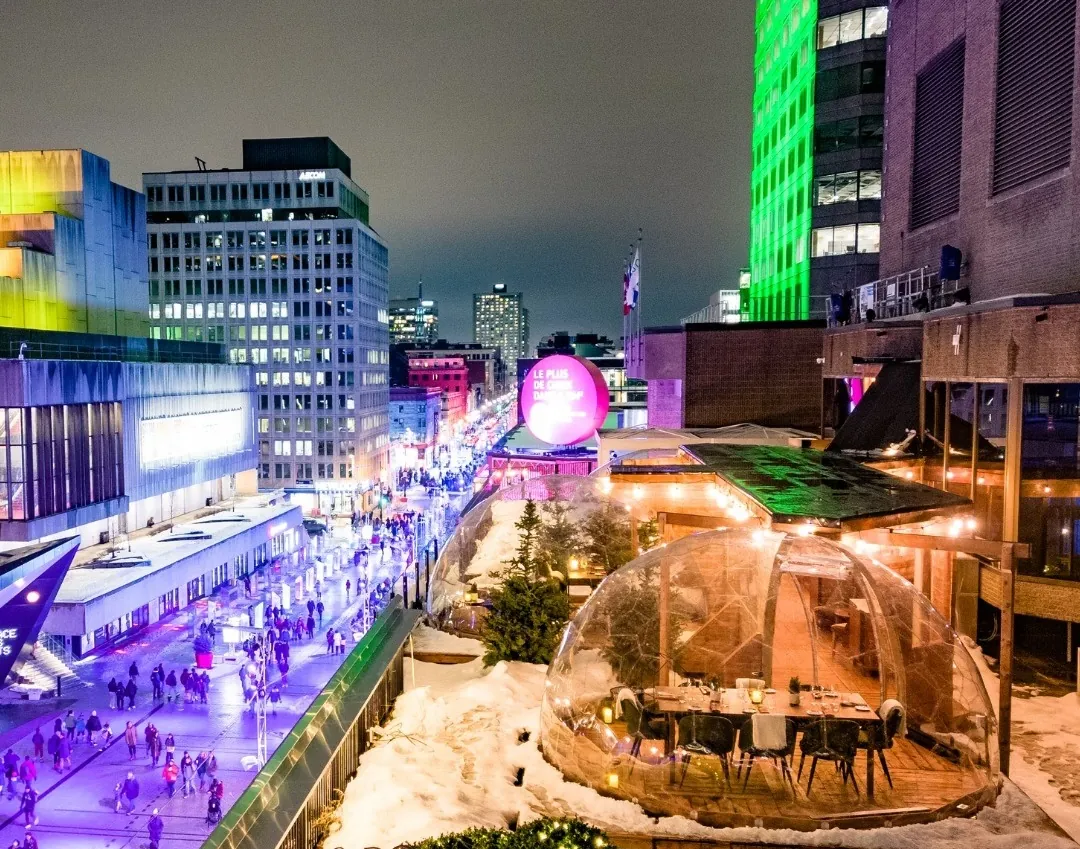
In addition to dining, geodesic domes are being used for weddings, corporate events, and music festivals due to their ability to create visually stunning, customizable spaces. Whether it’s for intimate gatherings or large festivals, their modular design allows event organizers to create unique environments that match the theme and atmosphere of the occasion.
Space Exploration & Research Stations
In the quest for sustainable habitats beyond Earth, geodesic domes have been proposed as potential structures for use on Mars. NASA has explored the feasibility of using these highly durable, lightweight structures in the harsh conditions of space and other planets due to their ability to withstand environmental stresses, including temperature fluctuations and atmospheric pressure differences.
Geodesic domes offer a unique advantage for space exploration due to their structural integrity and compact design, which makes them easy to transport and assemble in environments with limited materials. The spatial efficiency of geodesic structures ensures that they can house necessary systems while maximizing the available interior volume.
From wellness retreats to space habitats and sustainable communities, geodesic domes are pushing the boundaries of architecture and design. Their versatility, energy efficiency, and sustainability make them a valuable choice for a variety of industries, with endless possibilities for the future. As these trends continue to evolve, geodesic structures may become an integral part of our daily lives, offering both practical benefits and aesthetic appeal in unique and unexpected ways.
Geodesic Dome Design: The Art and Science of Dome Architecture
Geodesic domes are admired for their efficiency, strength, and futuristic aesthetic, but designing one is more than just assembling a set of triangular or hexagonal panels. The design of a geodesic dome determines its durability, insulation, flexibility, and overall functionality. Every detail, from its geometric complexity to the materials used, plays a crucial role in shaping its performance. Below are the key aspects that influence geodesic dome architecture today.
Geometry & Structural Integrity
At the core of a geodesic dome’s strength lies mathematical precision. The structural grid, often referred to as frequency (V1, V2, V3, etc.), affects the number of panels, the smoothness of the curve, and how the load is distributed across the structure.
- Low-frequency domes (V1, V2, V3) have fewer panels, giving them a more angular appearance. They are easier to construct and often used for small garden pods, saunas, and temporary shelters.
- High-frequency domes (V4, V5, V6+) contain a greater number of panels, creating a smoother, more spherical shape with increased weight capacity. These are better suited for residential homes, greenhouses, and large event spaces.
The higher the frequency, the more refined and aerodynamic the dome becomes. However, this also increases material requirements, construction complexity, and cost.
One of the best examples of advanced geodesic design is the Eden Project Biomes in the UK, which utilize a hex-tri-hex paneling system to maximize light transmission while maintaining a robust structure.
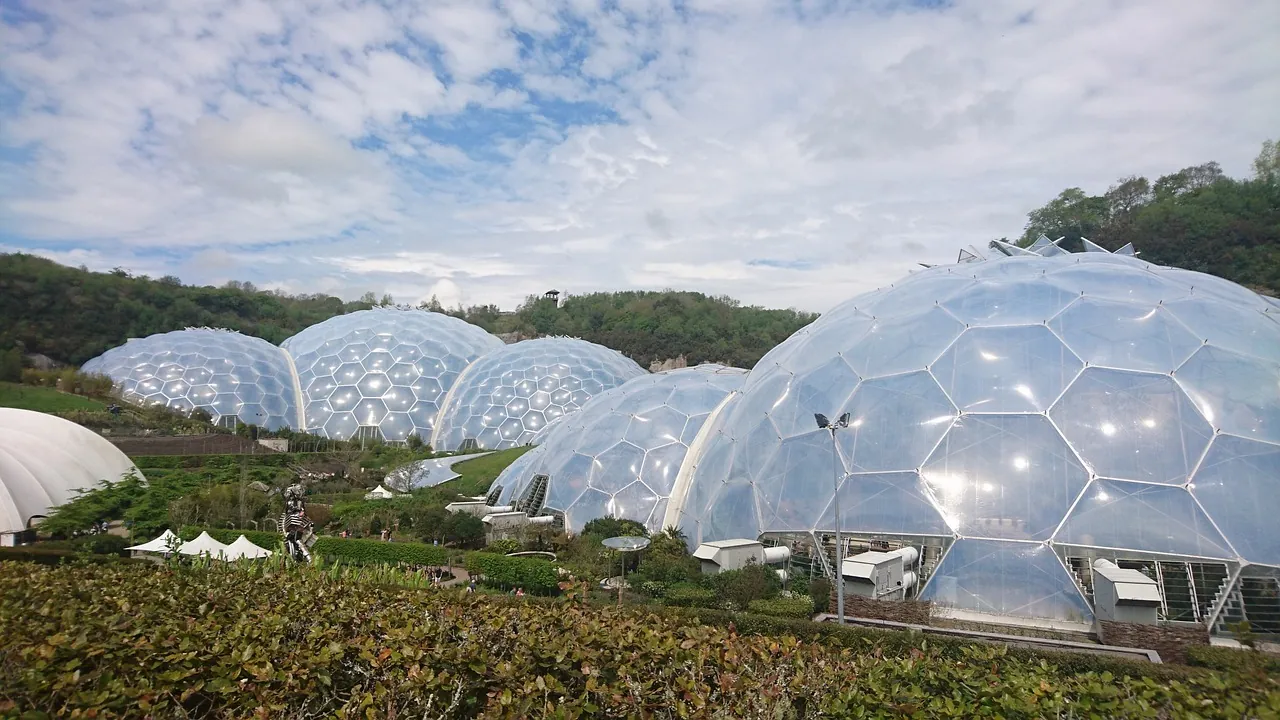
Biomes at the Eden Project in Bodelva
Material Choices & Their Impact
The selection of materials in geodesic dome construction defines weight, durability, insulation, and overall efficiency. Depending on the intended use, domes can be built as framed or frameless structures, each with unique advantages.
Structural Design: Framed vs. Frameless Domes
Before selecting materials, it is essential to consider the two primary construction approaches:
- Framed Geodesic Domes rely on an internal skeleton made from wood, steel, or aluminum, over which panels or membranes are attached. These designs offer higher load capacity, making them ideal for large-scale domes, permanent homes, and extreme weather conditions. The structural frame provides additional stability, allowing for internal modifications such as lofts or partitions.
- Frameless Geodesic Domes eliminate the need for an internal frame, using rigid self-supporting panels to form the structure. This approach ensures unobstructed interior views and reduces overall weight. Frameless domes are typically easier to assemble and are commonly used for greenhouses, garden pods, and event spaces. However, without a supporting framework, they may require thicker panels or specialized materials to maintain structural integrity.
Structural Materials (Frame or Shell)
The materials used in the dome’s core structure – whether as a frame or a self-supporting shell – affect its weight, longevity, and performance under different environmental conditions.
- Steel – Highly durable and ideal for large, permanent domes, but requires anti-corrosion coatings to prevent rust.
- Aluminum – Lightweight and rust-resistant, often used for temporary or portable domes.
- Wood – Aesthetic and natural-looking, offering good insulation, though it requires moisture protection in humid climates.
- Composite Materials – Carbon fiber, fiberglass, or high-performance polymer composites provide lightweight yet extremely strong alternatives, often used in modern high-tech dome constructions.
Covering & Paneling Options
The choice of outer shell materials impacts insulation, transparency, and weather resistance. Selecting the right covering is crucial for balancing energy efficiency, durability, and aesthetics.
- Polycarbonate – A popular choice for greenhouses, skylight domes, and hospitality spaces, offering UV resistance, transparency, and lightweight construction.
- ETFE (Ethylene Tetrafluoroethylene) – Used in large-scale domes, such as the Allianz Arena in Germany, known for superior light diffusion and weather resistance.
- Fabric & Membranes – Flexible and waterproof, making them ideal for temporary event domes and pop-up installations.
Each material presents trade-offs in cost, weight, insulation properties, and durability. The best choice depends on whether the dome is intended as a permanent residence, a temporary structure, or a climate-controlled environment.
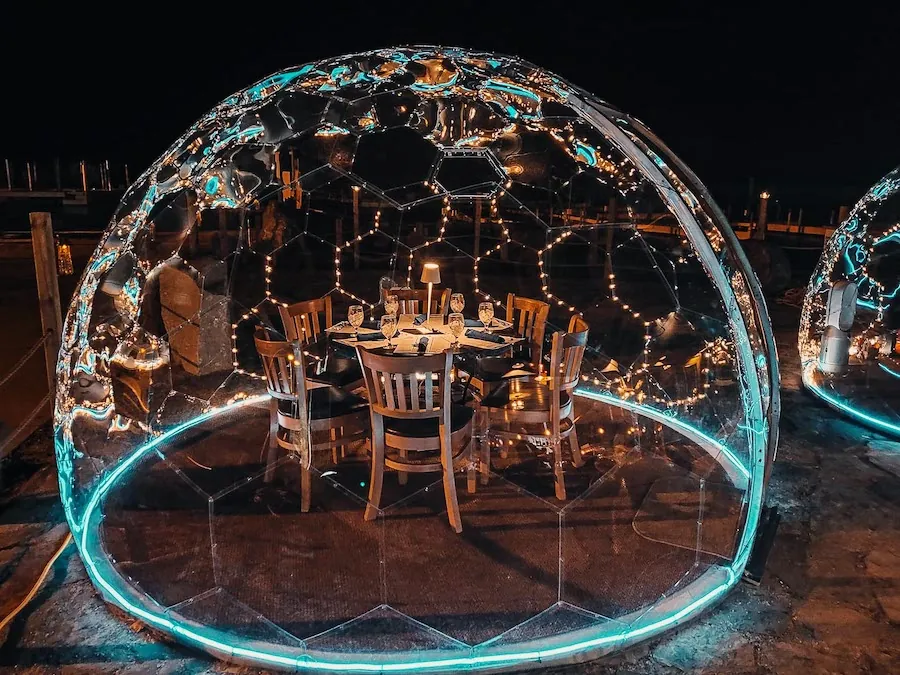
Hypedome polycarbonate frameless dome
Geodesic Dome Kits
Here at Hypedome, we’re enthusiastic about geodomes and have done our homework on the best ways to design and build them. If you want to build your own geodesic dome quickly and without any hitches, it’s best to use a ready-made geodesic dome kit designed by geodesic dome manufacturers.
Hypedome dome building kits include all the necessary components needed: panels, entrance frame, rollable zip door, anchoring feet, screws and nuts, and more. And you can choose to upgrade your dome with wide range of add-ons – we offer the complete dome package.

Geodesic dome kits are a solid, tested solution, ideal for those who don’t want the hassle of designing and building their dome from scratch. A kit can actually save money on costs (since much of the design and construction process has already been done).
In the true spirit of the original geodesic dome pioneers, we at Hypedome are giving you our own ‘access to tools’ — not just the physical components but the innovation and design that make our domes stand out. Hypedome kits are more than just a product; they’re an homage to a time-tested solution, combining the joy of DIY with the assurance of quality and the satisfaction of creating something truly unique — your very own geodome.
Geodesic Domes: Poised for a Modern Comeback?
Back in the swinging ‘60s and groovy ‘70s, geodesic domes were all the rage in niche circles, yet they never hit the big time in mass housing — tech limitations and the building business stick-to-what-you-know attitude played spoilsport. But times have changed. With our tech now in fast-forward and a hearty push for homes that are kind to the planet, those futuristic domes might just be on the brink of a comeback. Sturdy, energy-saving, and highly appealing, geodesic domes could be the next chapter in our home-sweet-home story. So, keep your eyes peeled — the dome home era might just be getting started.
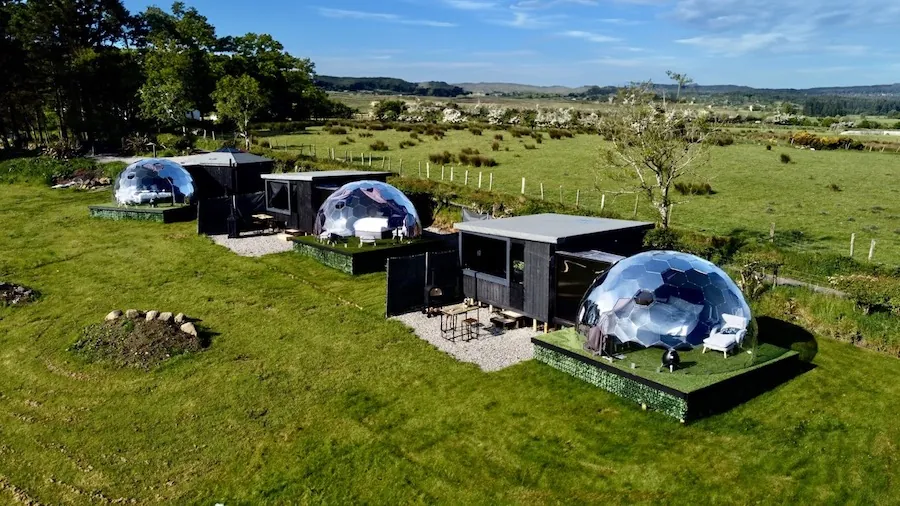
FAQs about Geodesic Domes
Here are answers to the most common questions we get asked about geodesic domes:
Are Geodomes Rainproof?
A properly designed, built and anchored insulated geodesic dome should not leak either through its walls or from the ground. Hypedome’s shell has been designed to function like fish scales – a protective layer that allows water to flow over the surface without leaking into the interior. Hypedome’s insulated modular floor or soft floor membrane also seal the dome from the ground to prevent water from getting inside.
Can Geodesic Domes Withstand Extreme Weather Conditions?
It depends on the materials used and whether the dome is securely anchored. A glass geodesic dome may not fare well in very hot or cold weather or bad storms (glass is quite prone to damage).
Geodesic domes are naturally resilient due to their aerodynamic shape and even load distribution. They can withstand strong winds, heavy snowfall, and even earthquakes better than many traditional buildings.
- Wind Resistance: The rounded shape prevents wind from exerting excessive pressure on a single side, reducing vulnerability to storms and hurricanes.
- Snow Load Handling: Unlike flat or sloped roofs, domes allow snow to slide off, minimizing the risk of structural collapse.
- Seismic Stability: Their interlocking triangles distribute stress efficiently, making them more earthquake-resistant than box-like structures.
However, performance depends on materials, foundation design, and proper anchoring. Poorly constructed domes may not offer the same level of resilience.
Hypedomes, made out of solid polycarbonate materials, have been designed to withstand heavy rain and strong winds up to 120 km/h. They can be built in areas with frequent snowfall and have been tested in even harsher weather conditions with positive results.
Can Geodesic Domes Be Used as Permanent Homes?
Yes, geodesic domes can serve as permanent homes, but their suitability depends on multiple factors such as climate, insulation, local building codes, and intended use.
- Advantages: Energy efficiency, durability, and open-concept living space.
- Considerations: Proper insulation is required for temperature regulation, and some areas may have zoning restrictions that impact dome home construction.
Key takeaway: Geodesic domes are viable for year-round living but require thoughtful planning regarding insulation, ventilation, and legal compliance.
How Much Do Geodesic Domes Cost?
If you’re looking for a geodesic dome to buy, you’ll find the price varies depending on size and materials. To give you an idea, Hypedome’s basic geo dome kit price starts at around £2,495 for the Mini size. You can check out the costs for all Hypedome kits and bundles in our online shop.
Can Geodesic Domes Be Customised to Fit Personal or Specific Architectural Needs?
Absolutely. Geodesic domes offer a high level of customization. From size and materials to window placements and interior layouts, these structures can be tailored to meet diverse architectural and personal preferences.
How Do Geodesic Domes Perform in Different Climates?
Geodesic domes excel in various climates due to their efficient aerodynamic shape and structural integrity. They can withstand heavy snow, strong winds, and even earthquakes. Moreover, their design allows for efficient air circulation, making them adaptable to both hot and cold climates.
Can Geodesic Domes Support Sustainable Living?
Geodesic domes align well with sustainable living principles. They require fewer building materials than traditional structures, are energy-efficient, can incorporate renewable energy sources like solar panels, and are conducive to natural heating and cooling methods.
Do Geodesic Domes Require Planning Permission?
The need for planning permission or building permits varies based on location, dome size, and intended use.
- Smaller domes (e.g., garden pods, greenhouses) may not require permits if they fall below a certain size threshold.
- Larger domes (e.g., full-time homes, commercial spaces) often need approval due to structural and zoning regulations.
- Utility connections (plumbing, electrical systems) may introduce additional permitting requirements.
Before construction, it’s best to check with local building authorities to ensure compliance with regional laws.
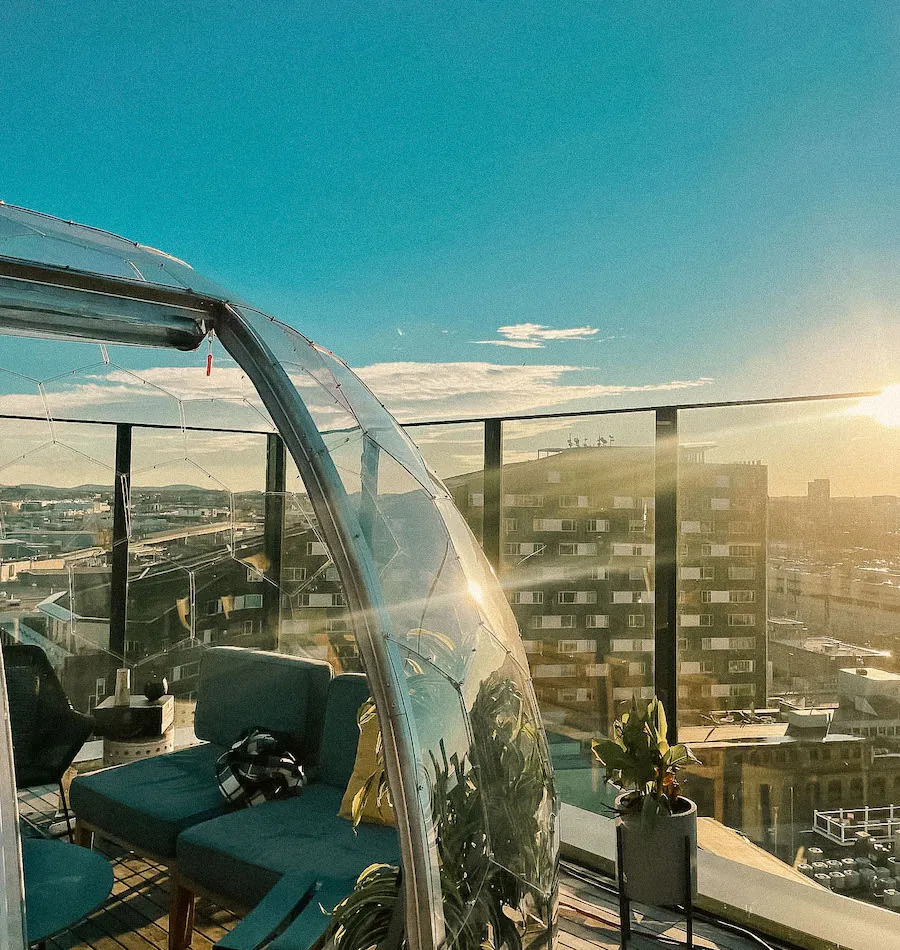
Thinking of dipping your toes into the geodesic trend? You don’t have to go all in from the get-go. Try out a garden geodesic dome to enhance your outdoor leisure. It’ll give you a cosy new spot to unwind and a sneak peek into the dome life — all without the big leap. Plus, you’ll be getting cosy in a space that’s a small-scale homage to those grand architectural dreams.
The only thing left to ponder is how you’ll use it… For an outdoor office or workout area? A games room for the kids? A private dining space or somewhere to unwind with a glass of wine while stargazing? Or perhaps for entertaining friends – which you’ll probably have a lot more of once you’re the proud owner of a beautiful dome!

